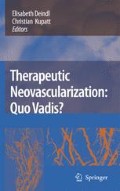Abstract
Antimicrobial peptides (AMPs) are effector molecules of the innate immune system. In addition their direct antimicrobial activity AMPs modulate angiogenesis. This chapter reviews the current knowledge about the link between AMPs and angiogenesis. A variety of AMPs have been isolated from species of all kingdoms and are classified based on their structure and amino acid motifs. AMPs have a broad antimicrobial spectrum and lyse microbial cells by interaction with biomembranes. Cathelicidins are characterized by a conserved N-terminal cathelin domain and a variable C-terminal antimicrobial domain that can be released from the precursor protein after cleavage by proteinases. LL-37 is the C-terminal part of the only human cathelicidin identified to date called human cationic antimicrobial protein (hCAP-18) and was first isolated from polymorphonuclear leukocytes but is also expressed by lymphocytes, macrophages and epithelial cells. LL-37 inactivates microorganisms by interaction with biomembranes. Beside the antimicrobial activity LL-37 modulates inflammation and displays different important cellular activities such as acting as chemotractant or activator of epithelial or immune cells. LL-37 interacts with endothelial cells and stimulates angiogenesis both in vitro and in vivo. LL-37 stimulates collateral formation in a rabbit hind-limb model of ischemia. Mice deficient for the murine analogue of LL-37/hCAP-18 showed decreased neovascularization of skin lesions as compared to wild-type controls. The angiogenic actions of LL-37 seem to be receptor-mediated by interaction with formyl peptide receptor–like 1 (FPRL1) that is expressed on endothelial cells. Cathelicidin is an example that AMPs serve as multifunctional host defense molecules and link antibiotic activity, repair and angiogenesis
Access this chapter
Tax calculation will be finalised at checkout
Purchases are for personal use only
Preview
Unable to display preview. Download preview PDF.
References
Zasloff M. Antimicrobial peptides of multicellular organisms. Nature 2002; 415(6870):389–95.
Brown KL, Hancock RE. Cationic host defense (antimicrobial) peptides. Curr Opin Immunol 2006; 18(1):24–30.
Nizet V, Ohtake T, Lauth X et al. Innate antimicrobial peptide protects the skin from invasive bacterial infection. Nature 2001; 414(6862):454–7.
Chromek M, Slamova Z, Bergman P et al. The antimicrobial peptide cathelicidin protects the urinary tract against invasive bacterial infection. Nat Med 2006; 12(6):636–641.
Moser C, Weiner DJ, Lysenko E et al. beta-Defensin 1 contributes to pulmonary innate immunity in mice. Infect Immun 2002; 70(6):3068–72.
Lehrer R, Ganz T, Selsted M. Defesins: endogenous antibiotic peptides of animal cells. Cell 1991; 64:229–230.
Goldman MJ, Anderson GM, Stolzenberg ED et al. Human beta-defensin-1 is a salt-sensitive antibiotic in lung that is inactivated in cystic fibrosis. Cell 1997; 88(4):553–60.
McCray PJ, Bentley L. Human airway epithelia express a beta-defensin. Am J Respir Cell Mol Biol 1997; 16(3):343–349.
Diamond G, Zasloff M, Eck H et al. Tracheal antimicrobial peptide, a cysteine-rich peptide from mammalian tracheal mucosa: peptide isolation and cloning of a cDNA. Proc Natl Acad Sci USA 1991; 88:3952–3956.
Bals R, Wang X, Wu Z et al. Human beta-defensin 2 is a salt-sensitive peptide antibiotic expressed in human lung. J Clin Invest 1998; 102:874–880.
Harder J, Bartels J, Christophers E et al. A peptide antibiotic from human skin. Nature 1997; 387:861.
Koczulla AR, Bals R. Antimicrobial peptides: current status and therapeutic potential. Drugs 2003; 63(4):389–406.
Beisswenger C, Bals R. Antimicrobial peptides in lung inflammation. Chem Immunol Allergy 2005; 86: 55–71.
Bals R. Epithelial antimicrobial peptides in host defense against infection. Respir Res 2000; 1(3):141–150.
Bals R, Wang X, Zasloff M et al. The peptide antibiotic LL-37/hCAP-18 is expressed in epithelia of the human lung where it has broad antimicrobial activity at the airway surface. Proc Natl Acad Sci U S A 1998; 95(16):9541–9546.
Yang D, Biragyn A, Hoover DM et al. Multiple Roles of Antimicrobial Defensins, Cathelicidins, and Eosinophil-Derived Neurotoxin in Host Defense. Annu Rev Immunol 2004; 22:181–215.
Heilborn JD, Nilsson MF, Kratz G et al. The cathelicidin anti-microbial peptide LL-37 is involved in re- epithelialization of human skin wounds and is lacking in chronic ulcer epithelium. J Invest Dermatol 2003; 120(3):379–389.
Shaykhiev R, Beisswenger C, Kaendler K et al. The human endogenous antibiotic LL-37 stimulates airway epithelial cell proliferation and wound closure. Am J Physiol Lung Cell Mol Physiol 2005; 289(5):842–848.
Agerberth B, Gunne H, Odeberg J et al. PR-39, a proline-rich peptide antibiotic from pig, and FALL-39, a tentative human counterpart. Veterinary Immunology & Immunopathology 1996; 54(1–4):127–31.
Koczulla R, von Degenfeld G, Kupatt C et al. An angiogenic role for the human peptide antibiotic LL-37/hCAP-18. J Clin Invest 2003; 111(11):1665–72.
Yang D, Chen Q, Schmidt AP et al. LL-37, the neutrophil granule- and epithelial cell-derived cathelicidin, utilizes formyl peptide receptor-like 1 (FPRL1) as a receptor to chemoattract human peripheral blood neutrophils, monocytes, and T-cells. J Exp Med 2000; 192(7):1069–74.
Steinstraesser L, Ring A, Bals R et al. The human host defense peptide LL37/hCAP accelerates angiogenesis in PEGT/PBT biopolymers. Ann Plast Surg 2006; 56(1):93–98.
Li J, Post M, Volk R et al. PR39, a peptide regulator of angiogenesis. Nat Med 2000; 6(1):49–55.
Conejo-Garcia JR, Benencia F, Courreges MC et al. Tumor-infiltrating dendritic cell precursors recruited by a beta-defensin contribute to vasculogenesis under the influence of Vegf-A. Nat Med 2004; 10(9):950–958.
Svendsen MN, Werther K, Nielsen HJ et al. VEGF and tumour angiogenesis. Impact of surgery, wound healing, inflammation and blood transfusion. Scand J Gastroenterol 2002; 37(4):373–379.
Peyssonnaux C, Datta V, Cramer T et al. HIF-1alpha expression regulates the bactericidal capacity of phagocytes. J Clin Invest 2005; 115(7):1806–1815.
Heilborn JD, Nilsson MF, Jimenez CI et al. Antimicrobial protein hCAP18/LL-37 is highly expressed in breast cancer and is a putative growth factor for epithelial cells. Int J Cancer 2005; 114(5):713–719.
Author information
Authors and Affiliations
Editor information
Editors and Affiliations
Rights and permissions
Copyright information
© 2007 Springer
About this chapter
Cite this chapter
Koczulla, R., Bals, R. (2007). Cathelicidin Antimicrobial Peptides Modulate Angiogenesis. In: Deindl, E., Kupatt, C. (eds) Therapeutic Neovascularization–Quo Vadis?. Springer, Dordrecht. https://doi.org/10.1007/1-4020-5955-8_10
Download citation
DOI: https://doi.org/10.1007/1-4020-5955-8_10
Publisher Name: Springer, Dordrecht
Print ISBN: 978-1-4020-5954-4
Online ISBN: 978-1-4020-5955-1
eBook Packages: Biomedical and Life SciencesBiomedical and Life Sciences (R0)

